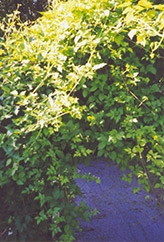Height: 15 feet
Spread: 12 inches
Sunlight:
![]()
![]()
Hardiness Zone: 3
Other Names: Vitis aconitifolia
Description:
This interesting vine has attractive leaves and berries which are blue turning yellow in late fall; vine clings to most structures and walls with tendrils great for screening and groundcover use in the garden
Ornamental Features
Monkshood Vine has rich green deciduous foliage on a plant with a spreading habit of growth. The deeply cut ferny leaves do not develop any appreciable fall color. It produces blue berries in early fall.
Landscape Attributes
Monkshood Vine is a multi-stemmed deciduous woody vine with a twining and trailing habit of growth. Its relatively fine texture sets it apart from other landscape plants with less refined foliage.
This is a relatively low maintenance woody vine, and is best pruned in late winter once the threat of extreme cold has passed. Gardeners should be aware of the following characteristic(s) that may warrant special consideration;
- Insects
Monkshood Vine is recommended for the following landscape applications;
- Hedges/Screening
- General Garden Use
- Groundcover
Planting & Growing
Monkshood Vine will grow to be about 15 feet tall at maturity, with a spread of 12 inches. As a climbing vine, it tends to be leggy near the base and should be underplanted with low-growing facer plants. It should be planted near a fence, trellis or other landscape structure where it can be trained to grow upwards on it, or allowed to trail off a retaining wall or slope. It grows at a medium rate, and under ideal conditions can be expected to live for approximately 30 years.
This woody vine does best in full sun to partial shade. It does best in average conditions that are neither too wet nor too dry, and is very intolerant of standing water. It is not particular as to soil type or pH. It is somewhat tolerant of urban pollution. This species is not originally from North America.
